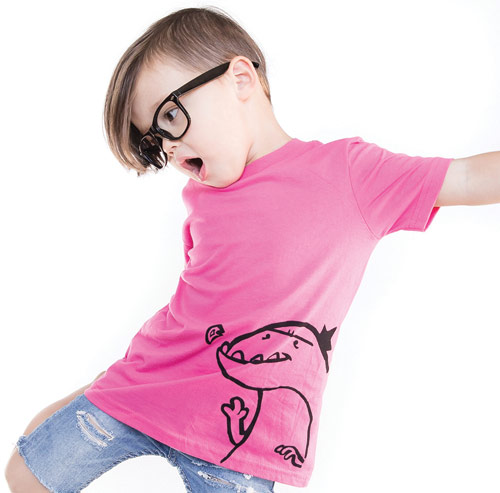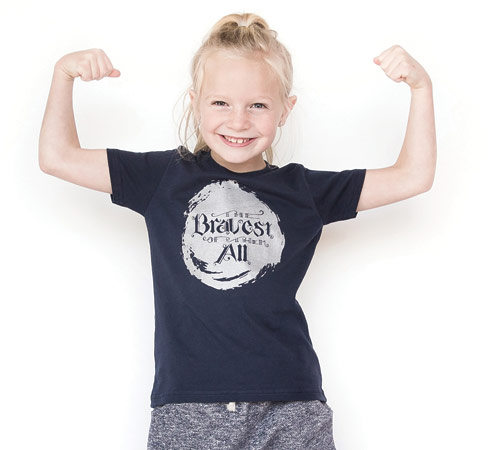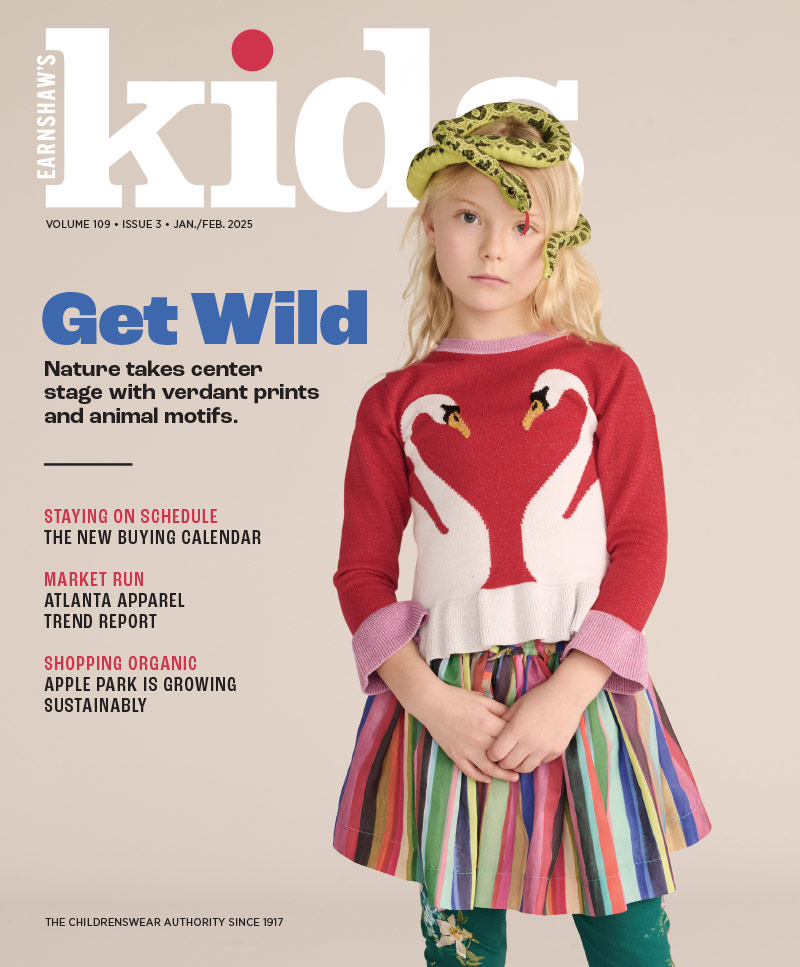“Gender neutral”, “unisex” and “gender inclusive” are the hottest terms in childrenswear lately, and some want to eliminate labels all together.
 Here’s what to know about the category, and what this individuality-first attitude means for the industry.
Here’s what to know about the category, and what this individuality-first attitude means for the industry.
We’ve long since realized that it is (more than) okay for boys to don shades of pink, and for girls to take on hues of blue. But as gender designations become increasingly less rigid and restrictive, fashion is embracing individuality and rejecting traditional thinking. And luckily for the generations to come, this trend is not just reaching childrenswear as an afterthought. In fact, the industry is trailblazing the movement. Some call it “gender inclusive,” others “unisex” and still others “gender neutral.” Some are presenting brands whose clothing focuses on one gender (or both), with the aim of battling stereotypes and empowering the wearer. Others still prefer not to refer to gender-anything at all and, instead, let the clothes—and the kids who choose them—speak for themselves. Martine Zoer, owner of Quirkie Kids, notes, “I wish we could just call it clothes for kids. Not just for boys. Not just for girls. But for kids.” She adds that using terms like “gender neutral” can cause needless confusion, leading some to believe the term applies to the children, not the clothes.
Emily Bennett, owner and designer of Baby Blastoff! defines “unisex” and “gender-neutral” clothing as synonymous while Eva Everett, co-founder of Svaha Apparel—a brand whose girls’ clothes have a specific STEAM-theme (Science/Technology/Engineering /Art/Math)—says that “gender-neutral” clothing showcases any topic, theme or color and is available to either gender, despite traditional societal gender constructs. “Unisex,” on the other hand, just means an item of apparel can be worn by a boy or girl, she opines. Others believe that the difference is just in the marketing, that “gender inclusive” is a more suited term, or that “unisex” refers more to a style or shape that is just traditionally both boy- and girl-appropriate. But while interpretations vary, the mission at the heart of the matter appears to remain the same: empowering the littlest members of society to embrace what they like and who they are.
Bennett, whose brand’s items are designed to be worn by both boys and girls, was inspired when she and her husband chose to not uncover the gender of their first child before his birth. “When we went looking for gender-neutral clothing, I was disappointed by the lack of exciting, inspired options, and I was appalled at the gender stereotype messaging that is everywhere on children’s clothing,” she recalls. In 2012, she launched an alternative to break down these stereotypes and encourage kids to explore the many possibilities of life. The result? Exciting plays on traditional color schemes and image combos, as well as a boy-friendly kilt debut for Spring ’17. Since pink and purple are stereotypical “girl colors,” her team put dinosaurs, trucks and science equipment on these colors to convey that science, engineering and ferocious animals can be for girls, too. “Masculine” colors are in turn represented by butterflies, soft and cuddly animals, and kitchen items to show that boys also can enjoy the domestic sphere and “a wide variety of animals, not just the ones with sharp teeth.”
 Katie Martino, founder and CEO of Entirely Me, remembers walking down retail aisles as a child, disliking that she was supposed to choose from only the “girls” options. The result is Entirely Me, which will be launching with a Kickstarter campaign this fall. Martino wants girls to decide whether or not they like dresses and pink colors and boys to decide whether they prefer blue—it should be the kid’s choice. “Before about the age of 8, boys’ and girls’ bodies are very similar, but as adults we choose to disassociate them,” she explains. She cites both traditional as well as new silhouettes as a part of the brand’s upcoming offerings, highlighting a “longline” style: essentially long shirts that can be used more like dresses or tees depending on the wearer’s preference—boy or girl.
Katie Martino, founder and CEO of Entirely Me, remembers walking down retail aisles as a child, disliking that she was supposed to choose from only the “girls” options. The result is Entirely Me, which will be launching with a Kickstarter campaign this fall. Martino wants girls to decide whether or not they like dresses and pink colors and boys to decide whether they prefer blue—it should be the kid’s choice. “Before about the age of 8, boys’ and girls’ bodies are very similar, but as adults we choose to disassociate them,” she explains. She cites both traditional as well as new silhouettes as a part of the brand’s upcoming offerings, highlighting a “longline” style: essentially long shirts that can be used more like dresses or tees depending on the wearer’s preference—boy or girl.
Everett, whose clothing is based on the concept that anyone, regardless of their gender, should be able to like and wear what they want to, says she was inspired to create her line because she has three little boys who adore pink, purple, butterflies and cats. “I thought it was pretty ridiculous that those things were completely unavailable in the boys’ section,” she reflects. “I wanted to make clothes to show my boys that any color or topic is available to them without limits.”
Similarly, Sharon Choksi, co-founder of Girls Will Be, says her direct-to-consumer brand was inspired by her young daughter questioning, “Why do boys get all the cool stuff?” Explains Choksi: “[My daughter] loved sharks and baseball and blue more than rainbows and kittens and pink, and every time we shopped for clothes, the things she loved only showed up in the boys’ department. I wanted to change that. I wanted girls to see a different message—that the world is theirs and they can like whatever they want, a message that there are no ‘boy’ things and ‘girl’ things, and a message that there are many different ways to be a girl.”
Melissa Atkins Wardy, CEO and founder of Pigtail Pals & Ballcap Buddies, adds that having a daughter opened her eyes to the sexism and sexualization that girls are exposed to at—unfortunately—very early ages. “Research has told us how harmful this is, so I wanted to create empowering apparel that spoke to how smart, daring and adventurous little girls are,” she says. “I wanted to focus on what girls can do, rather than what they look like while doing it.” The CEO launched Pigtail Pals in 2009, initially as a girls’ empowerment brand but added designs later to include boys and to address boy stereotypes, as well. She reintroduced the “gender-inclusive” company as Pigtail Pals & Ballcap Buddies in 2011.
But whether its playing with color schemes, testing out new silhouettes or using everybody-friendly prints, Bennett points out, “We are not yet culturally to the place where big ruffles and drapey silhouettes are worn by boys and men in the mainstream—I think this is a real shame.” She notes, “We have found that it is quite acceptable for parents to put their daughters in ‘boy’ clothing, but people are still quite uncomfortable putting feminine styles on their boys. Our designs, up to this point, have kept this in mind, relying mostly on masculine silhouettes while incorporating feminine colors and imagery.” Choksi adds that non-gender specific styles are still an emerging concept in the industry. “I believe the trend is definitely picking up speed in childrenswear, but it is still viewed as a niche and most big retailers either have not changed at all or are barely dipping their toe in the trend,” she explains.
Still, industry execs agree that “gender neutrality” and similar themes in childrenswear are growing far beyond the typical gender-neutral baby sections in retail stores that are for parents who don’t know the sex of their child yet. “The movement is building,” confirms Bennett, noting it’s becoming well-established in Europe. Everett says many parents are just plain fed-up with the sea of pink in the girls’ section and the grays/blues in the boys.’ Jo Hadley, owner and founder of Handsome in Pink, adds the category has been gaining momentum recently in part due to the rise of the Internet, and, particularly, social media. “Like-minded people from far distances are able to gather and effect change in a way that they weren’t before,” she explains. “Take Clothes Without Limits [an association dedicated to challenging gender clichés in childrenswear, whose participating companies include many of the brands mentioned in this article] for example, if it weren’t for the Internet, we would not have found each other. We would have remained small individual businesses filling a deficit in the market. But now look at us: We have come together and created a much bigger movement of empowering kids through relevant messages on our clothes.”
Choksi comments, “When we launched three years ago, numerous independent children’s retailers told us they liked the concept, but would not stock our line because it would be riskier than buying the pink, frilly, stereotypical ‘girly’ styles that they know will sell,” she recalls. “I think that belief is changing, and more boutiques would embrace our style today.”
Courtney Hartman, owner and designer of the Jessy & Jack and Free To Be Kids brands, believes that brick-and-mortar retailers are running behind. “In a typical retail store you seldom see butterflies, cats, the word ‘love,’ or the colors pink or purple in the boys’ section. You don’t often see empowering messages, math themes or ferocious animals in the girls’ section,” observes Hartman. Instead, she continues, the gender-bending apparel movement is “almost completely driven” by small, independent clothing brands like her own that sell online, directly to consumers who find the brands via social media. “The success of small direct-to-consumer brands like mine is largely a backlash against the limits that larger retailers and brands are placing on our children,” she affirms.
Zoer predicts that children’s clothing stores might look very different in the future. “A few years ago, there were no dinosaur dresses or space-themed pajamas for girls and now Mini Boden and Lands’ End carry such items,” she explains. “I think the same will happen to gender-neutral childrenswear—large retailers will pick up on the trend and start carrying gender-neutral items; perhaps a few at first and expand over time.” She anticipates a time when there will be a boys’ section, a girls’ section, and a gender-neutral section in all kids clothing stores. The co-founder of Clever Belle, Cindy Tank-Murphy, muses, “Maybe one day you won’t even be able to tell the difference between the boy and girl sections of the store.”
Bennett adds that we are about to see a generation of Millennials enter parenthood. “Millennials, more than previous generations, embrace gender role fluidity,” she says. “They are going to be parents that want alternatives to the traditional pink and blue and want to encourage their children to break out of gender-stereotyped roles.” She believes we will see great growth in the gender-neutral section over the next 10 to 15 years, noting that some larger retailers like Target already have made changes [the retailer announced last year it would stop labeling toys as solely for boys or girls]. Bennett says, “In the realm of toys, the stereotype box is being blown wide open with GoldieBlox and other STEM-related toys for girls and also lines of dolls just for boys. I am excited to see these changes, and I hope they continue to build and push limits even further.”
In regard to the success of these brands? “We have been flooded with positive support from customers,” says Everett. Atkins Wardy and Hartman both describe the response to their brands as overwhelming—in the best sense of the word. “I’ve been blown away,” offers Hartman. “I hope boys will wear our ‘Love Is My Superpower’ and ‘Mr. Nice Guy’ shirts and feel proud of their capacity for kindness and love. I hope girls will wear our ‘Smart Girls Club’ and ‘Math Rules Everything Around Me’ shirts, walk into the classroom this fall proud of their brains, and that they will fulfill their potential and be empowered.” She continues, “I hope all children will feel free to be themselves, whoever they want to be, and find their interests and favorite things represented on their clothing, regardless of gender.”
But the category still has a ways to go. Kristin Nystrom, creative director and founder of the Gardner and the Gang line—which has collaborated with model and actress Jaime King—acknowledges that while there are a lot of positive reactions to the approach, some parents feel offended or upset and others are still getting used to the idea.
But despite mixed reactions, brand execs agree that gender neutrality/inclusiveness in childrenswear tells kids that there is no right or wrong way to be a girl or boy. Atkins Wardy explains, “It sends the message there are no limitations, that each person has unique tastes and cool things about them. It helps children to have a broader picture of the world and who they can be in it.” She goes on to say, “As our kids grow, gender stereotypes, toxic masculinity, body image pressure and sexualization play a big role in their development. Apparel is a form of media, and kids learn a great deal from the media that surrounds them. It is our responsibility to send them the healthiest messages possible, and the current small businesses are proving you can do so and still make a profit.”
Hadley adds, “What kids wear affects the way they are treated by the outside world as well as the way they feel about themselves and what they think is possible for them in their lives.” Co-founders and chief creative officers of Princess Awesome, Rebecca Melsky and Eva St. Clair, sum up that “stereotype-busting” products are important because these clothes can send the message to kids that all colors are for all kids—as are dinosaurs, science, rainbows and kittens.
Everett explains that when we categorize things as “for girls” and “for boys” we are putting barriers on what kids think they should like and sending the message that certain interests are off-limits to them, based on their gender. “I feel it is very damaging to kids,” explains Everett. “If we want to fight gender inequality in our society, I believe we have to start when kids are young and show kids that their gender does not limit them from liking anything.” Tank-Murphy agrees, adding, “I hope our future girls grow up to learn that beauty is not what defines their success in life and that our boys grow to learn that being a strong man includes having a nurturing and sensitive heart.”
Bennett couldn’t agree more. “I believe that the way we talk to babies, interact with them, and care for them, impacts their future lives. Each child is a complex human with a wide range of interests and passions,” she says, explaining that it is her greatest hope that kids will grow up with a greater sense of self-confidence and emotional maturity because they were treated as the multifaceted individuals that they are. “In the end, we hope that customers consider the pink truck for their son and the brown and orange whisk for their daughter,” she says. “We believe that all colors are for everyone, and all children deserve the chance to wear a wide array of vibrant colors.” •





 FASHION IS MY PLAYGROUND
FASHION IS MY PLAYGROUND 
 The Chi
The Chi



 The
The

 The top expo for kids and baby
The top expo for kids and baby
 The 2025 Earnie Awards are officially OPEN! I
The 2025 Earnie Awards are officially OPEN! I


 From milestones to everyday magic, @ryleeandc
From milestones to everyday magic, @ryleeandc

 BEST IN SHOW: @milaandrose
Twirl-worthy, pla
BEST IN SHOW: @milaandrose
Twirl-worthy, pla





 This season’s
This season’s



Leave a Comment: